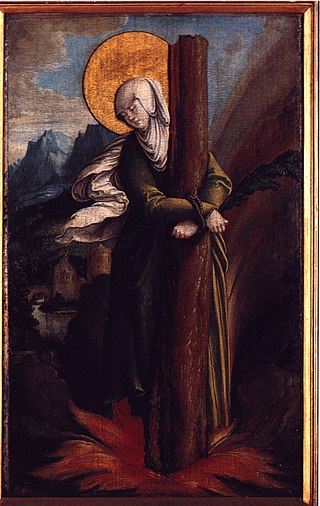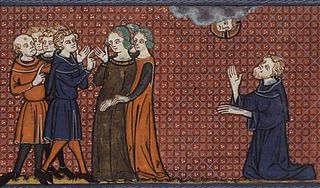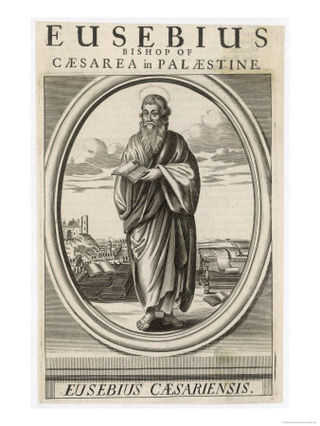Related Research Articles

Saint Afra was martyred during the Diocletian persecution. Along with Saint Ulrich, she is a patron saint of Augsburg. Her feast day is August 7. Afra was dedicated to the service of the goddess Venus by her mother, Hilaria. Through his teachings, Bishop Narcissus converted Afra and her family to Christianity. When it was learned that Afra was a Christian, she was brought before Diocletian and ordered to sacrifice to the pagan gods. She refused and was condemned to death by fire.

Babylas was a patriarch of Antioch (237–253), who died in prison during the Decian persecution. In the Eastern Orthodox Church and Eastern Catholic Churches of the Byzantine rite his feast day is September 4, in the Roman Rite, January 24. He has the distinction of being the first saint recorded as having had his remains moved or "translated" for religious purposes; a practice that was to become extremely common in later centuries.

Saint Apollonia was one of a group of virgin martyrs who suffered in Alexandria during a local uprising against the Christians prior to the persecution of Decius. According to church tradition, her torture included having all of her teeth violently pulled out or shattered. For this reason, she is popularly regarded as the patroness of dentistry and those suffering from toothache or other dental problems. French court painter Jehan Fouquet painted the scene of St. Apollonia's torture in The Martyrdom of St. Apollonia.
Saints Theodora and Didymus are Christian saints whose legend is based on a 4th-century acta and the word of Saint Ambrose. The pair were martyred in the reigns of co-ruling Roman Emperors Diocletian and Maximianus. St. Theodora should not be confused with another St. Theodora of Alexandria commemorated on September 11.

The Diocletianic or Great Persecution was the last and most severe persecution of Christians in the Roman Empire. In 303, the emperors Diocletian, Maximian, Galerius, and Constantius issued a series of edicts rescinding Christians' legal rights and demanding that they comply with traditional religious practices. Later edicts targeted the clergy and demanded universal sacrifice, ordering all inhabitants to sacrifice to the gods. The persecution varied in intensity across the empire—weakest in Gaul and Britain, where only the first edict was applied, and strongest in the Eastern provinces. Persecutory laws were nullified by different emperors at different times, but Constantine and Licinius' Edict of Milan in 313 has traditionally marked the end of the persecution.

October 3 - Eastern Orthodox liturgical calendar - October 5

Saint Blandina was a Christian martyr who died in Lugdunum during the reign of Emperor Marcus Aurelius.

January 29 - Eastern Orthodox liturgical calendar - January 31

Saints Cyprian and Justina are honored in the Catholic Church, Eastern Orthodox Church and Oriental Orthodoxy as Christians of Antioch, who in 304, during the Diocletianic Persecution, suffered martyrdom at Nicomedia on September 26. According to Roman Catholic sources, no Bishop of Antioch bore the name of Cyprian.

Julian and Basilissa were husband and wife, and are venerated as saints in the Roman Catholic Church and the Eastern Orthodox Church. They were Christian martyrs who died at either Antioch or, more probably, at Antinoe, in the reign of Diocletian, early in the fourth century, on 6 January, according to the Roman Martyrology, or 8 January, according to the Greek Menaea.

Nonnus was legendary 4th- or 5th-century Christian saint, said to have been an Egyptian monk who became a bishop in Syria and was responsible for the conversion of St Pelagia the harlot during one of the Synods of Antioch. His feast day is observed on November 10.

Christians were persecuted, sporadically and usually locally, throughout the Roman Empire, beginning in the 1st century AD and ending in the 4th century. Originally a polytheistic empire in the traditions of Roman paganism and the Hellenistic religion, as Christianity spread through the empire, it came into ideological conflict with the imperial cult of ancient Rome. Pagan practices such as making sacrifices to the deified emperors or other gods were abhorrent to Christians as their beliefs prohibited idolatry. The state and other members of civic society punished Christians for treason, various rumored crimes, illegal assembly, and for introducing an alien cult that led to Roman apostasy. The first, localized Neronian persecution occurred under Emperor Nero in Rome. A more general persecution occurred during the reign of Marcus Aurelius. After a lull, persecution resumed under Emperors Decius and Trebonianus Gallus. The Decian persecution was particularly extensive. The persecution of Emperor Valerian ceased with his notable capture by the Sasanian Empire's Shapur I at the Battle of Edessa during the Roman–Persian Wars. His successor, Gallienus, halted the persecutions.

Procopius of Scythopolis was a 4th century martyr who is venerated as a saint. He was a reader and exorcist in the church at Scythopolis; he also was famous as an ascetic and erudite theologian. Eusebius of Caesarea wrote of his martyrdom, which occurred during the persecution of Roman Emperor Diocletian, and stated that "he was born at Jerusalem, but had gone to live in Scythopolis, where he held three ecclesiastical offices. He was reader and interpreter in the Syriac language, and cured those possessed of evil spirits." Eusebius wrote that Procopius was sent with his companions from Scythopolis to Caesarea Maritima, where he was decapitated.

December 19 - Eastern Orthodox liturgical calendar - December 21

March 15 - Eastern Orthodox liturgical calendar - March 17

The Myth of Persecution: How Early Christians Invented a Story of Martyrdom is a 2013 book by Candida Moss, a professor of New Testament and Early Christianity at the University of Notre Dame. In her book, Moss advances a thesis that:
- The traditional idea of the "Age of Martyrdom", when Christians suffered persecution from the Roman authorities and lived in fear of being thrown to the lions, is largely fictional. Here she follows the work of G. E. M. de Ste. Croix.
- There was never sustained, targeted persecution of Christians by Imperial Roman authorities. Official persecution of Christians by order of the Roman Emperor lasted for at most twelve years of the first three hundred of the Church's history. Moss writes: "This does not mean, however, that there were no martyrs at all or that Christians never died. It is clear that some people were cruelly tortured and brutally executed for reasons that strike us as profoundly unjust."
- Most of the stories of individual martyrs amassed by the early modern period are pure inventions. She agrees with Bollandist scholar Hippolyte Delehaye that most martyrdom literature developed in the fourth century and beyond.
- Even the oldest and most historically accurate stories of martyrs and their sufferings have been altered and re-written by later editors, so that it is impossible to know for sure what any of the martyrs actually thought, did or said.

On the Martyrs of Palestine is a work by church historian and Bishop of Caesarea, Eusebius, relating the persecution of Christians in Caesarea under Roman Emperor Diocletian. The work survives in two forms, a shorter recension which formed part of his Ecclesiastical History, and a longer version, discovered only in 1866. Eusebius was present in Caesarea at the time of the persecutions he recounts.
Pelagia the Virgin, also known as Pelagia of Antioch, was a Saint and virgin martyr who leapt to her death during the Diocletianic Persecution rather than be forced by Roman soldiers to offer a public sacrifice to the pagan gods, or to do "something unspeakable ", typically inferred as the Roman soldiers attempting to rape her. She was 15 years old. Originally, her feast day was celebrated on October 8, in common with SS Pelagia the Harlot and Pelagia of Tarsus. In the Roman Catholic Church, it came to be celebrated on June 9 and, at Naples in Italy, she is celebrated on October 5.

Perpetua and Felicity were Christian martyrs of the 3rd century. Vibia Perpetua was a recently married, well-educated noblewoman, said to have been 22 years old at the time of her death, and mother of an infant son she was nursing. Felicity, a slave woman imprisoned with her and pregnant at the time, was martyred with her. They were put to death along with others at Carthage in the Roman province of Africa.
References
- 1 2 3 "Martyr Domnina with her daughters of Syria". www.oca.org. Retrieved 2023-05-05.
- ↑ "Saint Domnina the Younger of Syria". www.oca.org. Retrieved 2023-05-05.
- 1 2 Eusebius (332). "The Martyrdom of St. Domnina and Her Two Daughters". Fordham University Internet Medieval Sourcebook. Retrieved 2023-05-05.
- 1 2 "John Chrysostom delivers a homily On *Bernike, Prosdoke, and Domnina (mother and daughters, martyrs of Antioch, S01008), during their festival at Antioch (Syria). He recounts their story and suicide in the face of persecution, and invites the audience to venerate their coffins and bones. Written in Greek at Antioch, 386/397". The Cult of Saints in Late Antiquity. June 23, 2017. Retrieved 2023-03-24.
- 1 2 Nelson, Brooke (2016). "A Mother's Martyrdom: Elite Christian Motherhood and the Martyrdom of Domnina". Journal of Feminist Studies in Religion. 32 (2): 11–26. doi:10.2979/jfemistudreli.32.2.03. ISSN 1553-3913.
- 1 2 R., Moss, Candida. The myth of persecution: how early Christians invented a story of martyrdom. ISBN 0-06-210455-1. OCLC 849787274.
{{cite book}}: CS1 maint: multiple names: authors list (link)